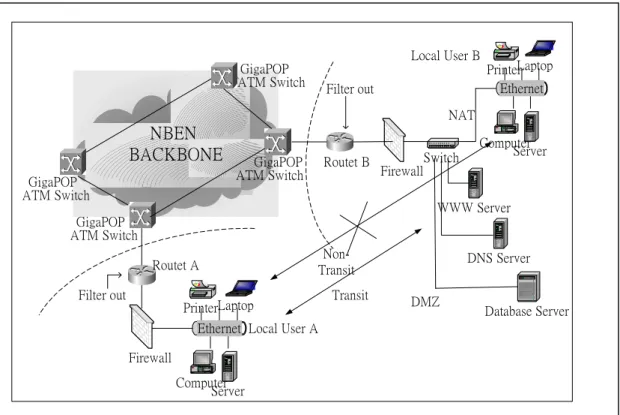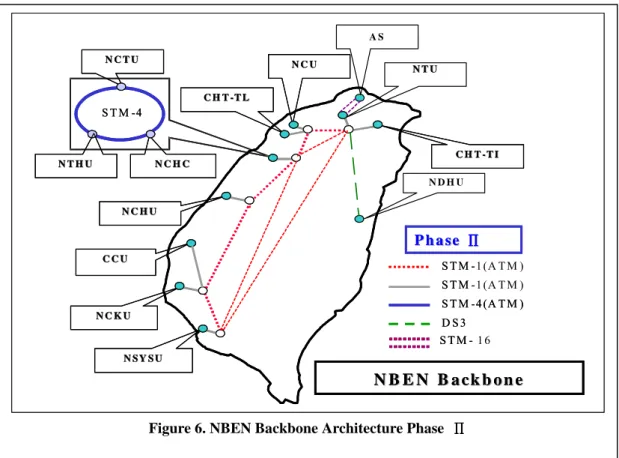Fully Routed IP Service of the NGN - the Case Study of the Routing Management for the NBEN
全文
(2) NC TU. NC U. NTU. CHT- TL. S T M - 4 CHT- TI NTHU. NCHC. NC HU. Phase I C CU. S T M - 1 (A T M ) S T M - 1 (A T M ). NCKU. S T M - 4 (A T M ) D S 3. NSYSU. N B EN B ac kbo ne Figure 1. NBEN Backbone Architecture The Internet users have grown significantly in Taiwan as the result of being promoted by government in launching several policies related to the Internet. However, the weakness of transmission in Internet along with its associated weakness in technology have become problems sooner than we expected. There are several examples like: 1) The growth of network scale is limited due to the restriction of space of IP address and the rigid approach of addressing method【1】 【2】. 2) Currently, network routing protocol is unable to completely support the quality of service (QoS)【3】. But, it is important to know that QoS is able to not only provide different functions for different users but can also increase the network margin by a wide margin. If the QoS can’t be guaranteed, then the capability of providing high quality will be affected directly plus its negative impact to the development in terms of the application of multimedia in networking【4】. 3) The router used to transmit the data in sending and routing process is time-consuming and provides very low efficiency, forming a primary bottleneck in Internet transmission. 4) At the present, the academic networking backbone in Taiwan is not well organized. In order to solve this problem and move toward the world of broadband, the current network routing protocol has to be integrated and re-established with a well-organized mechanism in response to the demands of new service style and new networking architecture.. The objective of this paper is to focus on the fourth point just mentioned above; that is, to solve the problem originated from the creation of Fully Routed IP service regarding NBEN. The main purpose of this study is to define a routing policy to secure this mechanism designed to separate trial and regular users without causing any interference for Fully Routed IP service with the addition of stepping forward to provide the service for DiffServ and QoS.. 3.Current Network Description NBEN project proposed to establish an experimental network with guaranteed quality is used to support the root project called National Science and Technology program for Telecommunication. It provides the capabilities to perform multimedia broadband application and act as a testing platform for advanced communication protocol. Its backbone transmission is based on the technology of ATM topology as shown in Figure 1. Since September 1999, NBEN has started the service. The primary transmission perch adopts OC-3 networking topology architecture and networking operation center (NOC) to provide IP address using Best Effort mode and to authorize each GigaPOP in assigning IP address. The academic networking environment can be classified into three major backbones such as TANet, TANet2, and NBEN. As shown in Figure 2, node A,B,C, and node 2.
(3) 1. 2 Router. 3 Router. TANet Backbone. Router. TANet/I2 Backbone. Router. NBEN Backbone. Router. A. Router. B. C. Node 1、2、3、A、B、 C 為 Local User Unit TANet、TANet/I2、NBEN 為 Backbone. Figure 2. Networking Backbone in Taiwan The regulations, supervision policy, and Internet operation principals of TANet are designed to provide the research activities for schools and research in Taiwan【5】. Additionally, they can share their networking resources and promote the NII experimental project to unfold the e-mail system in Junior and elementary schools. The regulation for using TANet2 has been defined to provides the usage of Fully routed IP over ATM for universities, research institutes supported by government, and other non-profit research organizations【6】. The regulation for using NBEN clearly defines that its purpose is to provide service for academic backbone networking and technology research of national telecommunication【7】. As shown in Figure 2, node 1,2,3,A,B,C, are all legal organizations with authorization to use these three networking systems. Functionally, they are classified based on the regulations and policies defined by each backbone. For example, node 1 and node A comply with the regulations and standards set by TANet so they can connect with TANet backbone. Node 2 and node B comply with the regulations and standards set by TANet and TANet2 so they can connect with TANet and TANet2. Likewise, node 3 and node C comply with the regulations and standards set by TANet, TANet2, and NBEN so they can use the service provided by all these three backbones.. 1,2,3, are three different kinds of units legally used. For example, node 1 and node A are legal units for TANet, node 2 and node B are legal units for TANet and Tanet2, and node 3 and node C are legal units that can be used in all three backbones. Therefore, all these six legal units are represented on many academic organizations which are currently using TANet, TANet2, and NBEN to connect with Internet.. 4. Routing Policy in “NBEN” Backbone 4.1. Classification for Using Academic Internet The population of Internet users have increased dramatically through the efforts made by government for education purpose. But there are only three academic networks available in Taiwan:they are TANet、TANet 2 and NBEN. Therefore, organizations that need to apply for the permission to use Internet plus organizations that already have the privilege will create a lot of work-load in the foreseeable future. In order to meet the demands of maintaining the quality of academic networking plus the normal connection with Internet from academic backbone without any interruption, both on-line rules, Internet protocol, and management policies are required as we establish the networking for academic networking from the start. 3.
(4) documented very clearly in AUP (acceptable use policy). There are still some technical problems and bottlenecks to be resolved. The detailed issues and problems are described as follows from the standard of users (Node 3 and Node C in Fig. 2) and GigaPOP.. 4.2. Priority of Routing The number of users authorized to use these three academic backbone networks can be differentiated in decreasing order as: TANet, TANet2, and NEBN. However, this order is changed to NBEN, TANet, and TANet2 as far as the bandwidth is concerned. Assuming that the network traffic is proportional to the number of users, then a factor defined as the ratio between the bandwidth and the number of users can be used as an indicator. Under this premise, NBEN has the highest value, the next one is TANet2, TANet is the last. In terms of quality of network transmission: NBEN is the best, TANet2 is the second. TANet with its large number of users has the poorest quality. A reasonable recommendation in selecting the routing priority is listed in Table 1. Table 1. Routing Priority Unit Routing Priority. 5.1.Local User 5.1.1. Routing Protocol for Local User Local user is simply an internal networking user without any connection to Autonomous System. Under the circumstances, we can consider the routing protocol as static routing or IGP in dynamic routing. Currently, there are two different routing protocols in IGP, i.e., Distance Vector and Link State【8】. In the mean time, the protocol of distance vector can be divided into three main sectors: RIP, IGRP, EIGRP. However, Cisco has the ownership of IGRP and EIGRP【9】. Therefore, RIP is the only consideration in terms of routing protocol of distance vector. Whereas link state is using OSPF as a representative despite the fact that there are two more routing protocols such as IS-IS, and NLSP【10】.. Node 3 and Node C NBEN>TANet 2>TANet Node 2 and Node B TANet 2>TANet Node 1 and Node A TANet only. 4.3. Network Packet Transmission. 5.1.2. Choice of Routing Path. Basically, the transmission of network packet can be conducted through the connection of academic backbone. As shown in Figure 2, 3 and C are qualified for the standards of using TANet, TANet2, and NBEN. Nevertheless, NBEN is not responsible for the transmission of packet; therefore, 3 can’t transmit packet to C through NBEN, and vice versa. As a result, 3 and C have to use the path of TANet2 or TANet to transmit packet to release unnecessary load in NBEN. The following is a reasonable suggestion to be used as the prioritized path in transmitting the packet.. Thus, an accurate routing path is determined to achieve a normal connection and faster transmission requirement. If the destination of IP address is located within the routing tables of TANet, TANet2, and NBEN, a routing transmission will be conducted through the NBEN first without violating the policy of NBEN in terms of its no transit service, according to the routing policy described in NBEN. In the mean time, TANet and TANet2 are set up as a backup. If the routing type belongs to the transit service, then TANet and TANet 2 will do the transmission without going through NBEN.. Table 2. Priority for Routing Package Transmission Priority for routing package Unit transmission Transit Non-Transit Node 3 NBEN>TANet 2 TANet 2>TANet Node C >TANet Node 2 TANet 2>TANet TANet 2>TANet Node B Node 1 TANet only TANet only Node A. 5.2.GigaPOP 5.2.1. Routing Protocol for GigaPOP Currently, NBEN backbone consists of 11 GigaPOPs with which they form a ring type of ATM academic backbone. Each GigaPOP can connect to an intra domain node through only one link. The routing protocol of GigaPOP is the protocol designed for connecting each GagaPOP, which is the same as the protocol that needs to be adopted by NBEN. Currently, the networking topology of NBEN is a homogeneous and closed networking; so its routing protocol uses Interior Gateway Protocol (IGP). IGP can be classified into two different. 5. Description of routing policy for NBEN backbone The purpose of having NBEN and its associated obligation in checking the network users for their privilege and responsibility is 4.
(5) Router. TANET 2 BACKBONE Router. GigaPOP. NBEN BACKBONE. Router. GigaPOP. GigaPOP GigaPOP Router WAN. RIP (EIGRP). Static Route. Printer Laptop Ethernet Local User. Router Firewall LAN Computer Server Figure 3. NBEN Backbone Local User Routing Design routing protocols: distance vector and link state. Furthermore, distance vector contains the following routing protocols: RIP, IGRP, EIGRP, RTMP, and IPX RIP, whereas the link state includes OSPF, IS-IS, and NLSP. AS far as the backbone networking is concerned, its routing protocol has to be applied for large scale networking system with the capabilities of not taking too much bandwidth and possessing faster renewal rate for networking topology. Although NBEN is an academic backbone of ring ATM type composed of 11 GigaPOPs belonging to a single autonomous system of enclosed network, a testing task of international cooperation research can be progressed after connecting to the international academic backbone through TANet2. Therefore, we have to start considering the compatibility issues in terms of routing protocol with EGP (exterior gateway protocol). At the present, BGP and AURP are two authorized routing protocols from EGP【11】. In the future, we will face the compatible issue between IGP and EGP【12】.. 5.2.3. Simplification of Routing Table The sending and receiving of networking packet is executed by using the routing table in the router. Thus, maintaining the routing table is a tiresome job. If the static routing is used to set up the routing table, although the loading of networking is decreased and the routing speed is increased, there will be problems involving the lack of efficiency and flexibility. If the dynamic routing is used to set up the routing, then router’s memory loading will be increased because the declaration of each every subnet. However, if we could design the routing protocols that support CIDR and summarization function by using the continuous nature of public IP address coupled with the same subnet in NBEN, then we will cut down the complexity and promote the performance and efficiency of networking.. 6. Plan to solve the problem of routing policy in NBEN backbone 6.1.Local User. 5.2.2. Prevention of Unnecessary Transit Service. 6.1.1.Using Static Routing Protocol. All the connections of networking organizations can’t transit their traffics through NBEN unless permitted by the committee of NBEN as required by their protocol. If the traffics need to transit through the GigaPOP, then it is GigaPOP’s responsibility to check their authorization.. In this study, the static routing is recommended for local user’s routing protocol. It arises from the facts that the routing protocols of RIP and OSPF have certain drawbacks that are not appropriate to be used as a transfer method for local users to connect themselves to 5.
(6) 每㆒個GigaPOP皆為獨立的Area NBEN Backbone Area 4. Router Router. ABR Router Area 0 Router Router. Area 5. Router. Autonomous System (AS) Area 1 Router. Router. Router ABR Router ABR Router Router. ABR Router Area 3. Router. Router Area2. ABR Router. Router. Figure 4. NBEN Backbone GigaPOP Routing Design transfer it. Then, local user can reconnect the line through TANet2 or TANet as back up connection.. NBEN backbone. The detailed information is described as follows: (1) The updating of RIP routing is to renew its routing table completely. The convergence time of routing table becomes slower as the scale of backbone becomes larger. Consequently, it will take more bandwidth as compared with the rest of protocols. (2) RIP adopts the routing technology of Split Horizon and Poison Reverse to prevent the routing loop, therefore making the updating of routing much longer than before【13】. (3) OSPF routing protocol can set up different area and different policy under one AS, and connect to each other through ABR (area border router). In addition, it can set up different routing policy in different AS to connect with each other through ASBR (autonomous system boundary router)【14】. Therefore, OSPF routing protocol is the most flexible one in terms of link state mode, and it is also the most complicated one in terms of the configuration. At the present, local user networking connection is simply a point to point networking connection.. 6.2.GigaPOP 6.2.1.Using OSPF Routing Protocol(Figure 4) Currently, RIP and OSPF are two IGPs that are easy to control. In this study, it is suggested that the routing protocol is constructed by using OSPF in each GigaPOP. The reason of adopting this routing protocol is written as follows: (1) OSPF routing protocol is a well-known protocol with accepted standard. It means that its compatibility is higher. (2) OSPF routing protocol adopts multicast format to transfer packet, which is different from the rest of broadcast format. Therefore, it can reduce the usage potency of each host’s CPU. As a result, the performance of working on the multimedia application experiment and broadband network testing is much higher【15】. (3)MOSPF provides multicast extensions to the popular unicast routing protocol, OSPF. MOSPF also provides for inter-area routing between multiple OSPF domains, which may be set upwithin an Autonomous System. This strategy is often implemented so as to reduce the computing requirements at any individual router and thereby improve performance【16】. As shown in Figure 4, each GigaPOP is using Fore system ASX-1000 ATM switching to connect with GigaPOP in different area. The. 6.1.2. Policy to Choose Routing Path for Local User(Figure 3) As mentioned above, it can avoid setting up a complex and dynamic routing path if adopts a static routing protocol. If the routing needs no transit service, then it can be connected through NBEN. On the other hand, if the routing violates the no-transit principal, the router will not 6.
(7) Local User B GigaPOP ATM Switch. Filter out. PrinterLaptop Ethernet. NAT. NBEN BACKBONE GigaPOP ATM Switch. GigaPOP ATM Switch. Routet B. Switch. Computer Server. Firewall WWW Server. GigaPOP ATM Switch NonTransit. Routet A Filter out. Transit. PrinterLaptop. DNS Server DMZ. Database Server. Ethernet Local User A Firewall Computer Server. Figure 5. NBEN Backbone Non-Transit AS provide public IP address and they are located in the GigaPOP B’s local area. We can use filter out policy to eliminate DMZ servers’ IP address to allow more users to use GigaPOP’s local area.. advantage of using OSPF is that OSPF belongs to the routing protocol of link-state and the routing information is delivered by using constant LSAs (link state advertisements) passing over to routers located in the same area. After that, a SPF (short path first) mechanism is used to determine the shortest routing path. With this approach, the independent area can calculate the shortest path to save the time and bandwidth that could have been wasted by exchanging the routing table.. 6.2.3.Support of Summarization Function OSPF routing supports route summarization. As long as the routing entry has the same subnet in one area and its IP address plus submask are continuous, then there is no need to transmit the routing table in each subnet. Only the domain located in the area will be transmitted as the routing table is broadcasted. This will decrease the unnecessary packets or net flow in the networking backbone. If the network area is sensitive, then there will be no summarization to prevent the damage created by hackers.. 6.2.2. Implementation of Non-Transit AS (Figure 5) There are only way of implementing non-transit AS policy in NBEN academic backbone. It is to use filter out configuration in each GigaPOP router to establish non-transit AS. By doing this thing, NBEN will become a non-transit backbone. As shown in Figure 5, local user A can connect with NBEN through GigaPOP, and local user B can connect with NBEN through GigaPOP router B. They all belong to the intranet. In order to achieve the non-transit policy, the configuration of filter out policy at serial port connecting GigaPOP router A and GigaPOP router B becomes necessary. Local user A can’t connect with local user B through NBEN after the configuration of filter out policy is done. However, there are some legal networking servers (WWW, DNS, Database Server) called DMZ, which are in service to. 7.Summary The purpose of proposing this NBEN project is to follow the development trend of international telecommunication technology in researching the key technology in broadband network. At the initial stage of implementing the NBEN plan, we have established Mbone application and completed the testing of advanced network protocol including Ipv6, RSVP, and IP multicasting. In the future, theobjective is to upgrade backbone to include STM-3 or STM-16 and to join other GigaPOP such as Sinica and National Dong Hwa University as planned in Phase II (Figure 6). 7.
(8) AS NCTU. NCU. NTU. C H T -T L. S T M -4. NTHU. C H T -T I. NCHC. NDHU NCHU. P h a se Π CCU. S T M --1 (A T M ) S T M --1 (A T M ) S T M -4 (A T M ). NCKU. DS3 STM - 16. N SY SU. N B E N B a ck b o n e Figure 6. NBEN Backbone Architecture Phase Π 【11】Halabi , B. “Internet Routing Architecture”, Cisco Press, New Riders Publishing, 1997. 【12】Varadhan, K. S. Hares and Y. Rekhter. “BGP4/IDRP for IP-OSPF Interaction”, RFC1745, December, 1991. 【13】Douglas E. Comer and David L. Stevens, “Internetworking With TCP/IP Volume Π”, Prentice Hall, 1991. pp344-347. 【14】Jeff Doyle, ”CCIE Professional Development: Routing TCP/IP Volume 1”, Cisco Press, 1998. 【15】John T. Moy, “OSPF:Anatomy of an Internet Routing Protocol” , Addison Wesley, 1998, pp.171-186. 【16】C. Kenneth Miller, “Multicast Networking and Applications”, Addison Wesley, 1999, pp.34-46.. In addition, we also need to research the advanced networking technology or application such as Differentiated Service. Finally, we would like to work with each team and support one another to help Taiwan control the key technology in the area of broadband networking.. 8.Reference 【1】S. Bradner & A. Mankin, “IP: Next Generation (IPng) White Paper Solicitation”, RFC1550”, December 1993. 【 2 】 S. Bradner & A. Mankin,, “The Recommendation for the IP Next Generation Protocol”, RFC1752, January 1995. 【3】Paul Ferguson & Geoff Huston, “Quality of Service” , John Wiley & Sons, Inc. 1998, pp.44-53. 【4】Thomas A. Maufer, “Deploying IP Multicast in the Enterprise” , Prentice Hall, 1998, pp.3-17. 【5】教育部,http://www.edu.tw/tanet/index.html. 【6】國科會, 「台灣研究網路使用規範及路由政策」 (http://www.tanet2.net.tw) ,民國 88 年 2 月。 【7】國科會, 「國家實驗網路建置計畫成果報告 書」 ,民國 88 年 11 月。 【8】Steenstrup, M. “Routing in Communications Networks” , Prentice Hall, 1995. 【9】Cisco Systems, “Introduction to Enhanced IGRP” , Cisco Technology Report #3. 【10】Radia Perlman, “Interconnection, Second Edition, Bridges, Routers, Switches and Internetworking Protocol” Addison Wesley, 2000, pp367-448.. 8.
(9)
數據
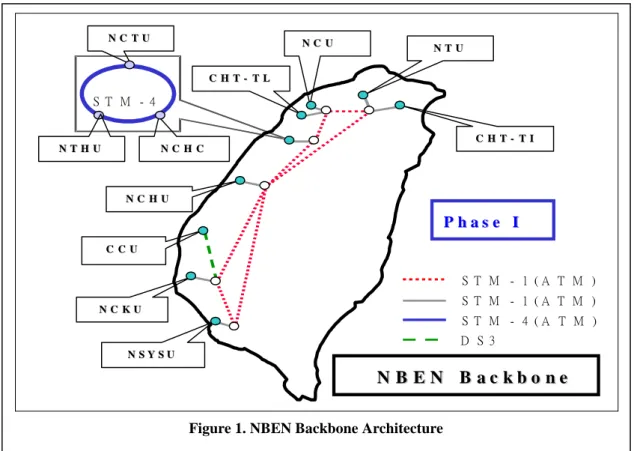
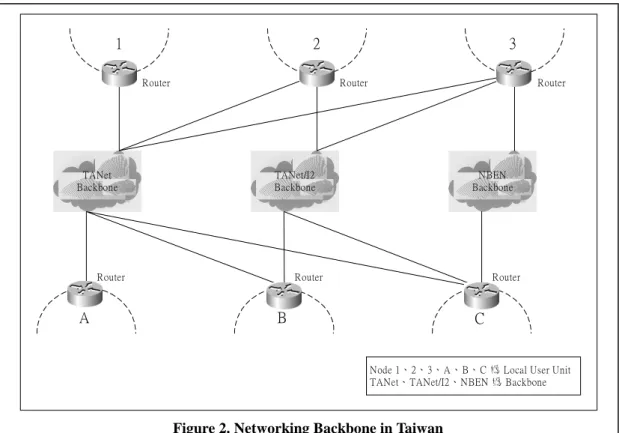
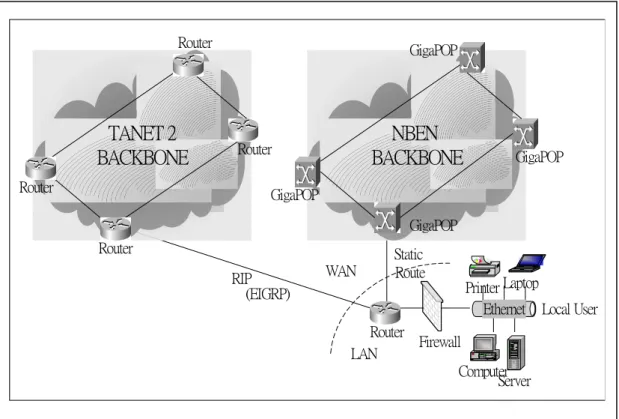
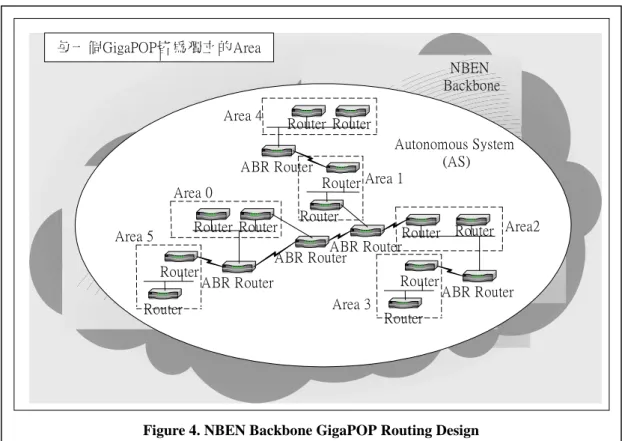
相關文件
volume suppressed mass: (TeV) 2 /M P ∼ 10 −4 eV → mm range can be experimentally tested for any number of extra dimensions - Light U(1) gauge bosons: no derivative couplings. =>
For pedagogical purposes, let us start consideration from a simple one-dimensional (1D) system, where electrons are confined to a chain parallel to the x axis. As it is well known
The observed small neutrino masses strongly suggest the presence of super heavy Majorana neutrinos N. Out-of-thermal equilibrium processes may be easily realized around the
incapable to extract any quantities from QCD, nor to tackle the most interesting physics, namely, the spontaneously chiral symmetry breaking and the color confinement..
(1) Determine a hypersurface on which matching condition is given.. (2) Determine a
• Formation of massive primordial stars as origin of objects in the early universe. • Supernova explosions might be visible to the most
2-1 註冊為會員後您便有了個別的”my iF”帳戶。完成註冊後請點選左方 Register entry (直接登入 my iF 則直接進入下方畫面),即可選擇目前開放可供參賽的獎項,找到iF STUDENT
The difference resulted from the co- existence of two kinds of words in Buddhist scriptures a foreign words in which di- syllabic words are dominant, and most of them are the
